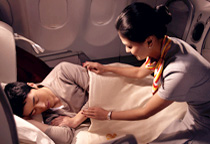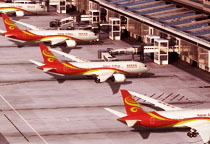Limites de bagages à transporter

Limits on baggage transportation
A.Prohibited items
Passengers are not allowed to place the following items in their checked baggage or carry them into the passenger cabin; otherwise Hainan Airlines and Grand China Air will refuse to provide transportation services.
I. Firearms and other weapons (including major components), devices capable of firing ammunition (including projectiles and other items) and causing serious personal injury or items that could be mistaken for such devices, mainly including: military guns, official guns, civilian guns, prop guns, firing guns, ball guns, guns outside the country, all kinds of illegally manufactured firearms and simulations of the above items, etc.
II. Dangerous goods, capable of causing serious personal injury or endangering the safety of aircraft and posing a greater danger to the order of transportation, including explosives, gases, flammable liquids, flammable solids, spontaneous combustion substances, substances that release flammable gases in contact with water, oxidizers, organic peroxides, toxic substances, infectious substances, radioactive substances, corrosives and substances and articles not belonging to any of the above categories but dangerous in air transportation. Mainly includes:
- Explosive or incendiary substances and devices or items that could be mistaken for such devices (substances), including ammunition, blasting equipment, pyrotechnic products and simulations of the above items.
- Compressed and liquefied gases, such as hydrogen, methane, ethane, butane, natural gas, ethylene, propylene, acetylene (dissolved in medium), carbon monoxide, liquefied petroleum gas, freon, oxygen (including liquid oxygen devices), carbon dioxide, water gas, lighter fuel and liquefied gas for lighters.
- Spontaneous combustion items, such as yellow phosphorus, white phosphorus, nitrocellulose (including film), oil paper and its products.
- Flammable items in contact with moisture, such as metal potassium, sodium, lithium, calcium carbide (calcium carbide), magnesium and aluminum powder.
- Flammable liquids, such as gasoline, kerosene, diesel, benzene, ethanol (alcohol), acetone, ether, paints, thinners, rosin oil and products containing flammable solvents.
- Flammable solids, such as red phosphorus, flash powder, solid alcohol, celluloid, blowing agent.
- Oxidizing agents and organic peroxides such as potassium permanganate, potassium chlorate, sodium peroxide, potassium peroxide, lead peroxide, peracetic acid, hydrogen peroxide.
- Toxic products, such as cyanide, arsenic, highly toxic pesticides and other highly toxic chemicals.
- Corrosive substances, such as sulfuric acid, hydrochloric acid, nitric acid, sodium hydroxide, potassium hydroxide, mercury (mercury).
- Radioactive materials, such as radioactive isotopes.
- Other items that implicitly contain one or more hazardous materials.
III. Control instruments that have the potential to cause personal injury or pose a significant risk to aviation safety and transport order, mainly including control knives, military and police instruments, and other control instruments as stipulated by the state.
IV. Other articles that have the potential to cause personal injury or pose a significant risk to aviation safety and transport order, mainly including
- Infectious disease pathogens, such as hepatitis B virus, anthrax bacillus, tuberculosis bacillus, and AIDS virus.
- Tinder (including various ignition devices), such as lighters, matches, cigarette lighters, and magnesium rods (flints).
- Power banks and lithium batteries with a lithium content of more than 8 grams or a rated energy of more than 160WH (watt-hours) (lithium batteries used in electric wheelchairs are otherwise regulated).
- Alcoholic beverages with an alcohol volume percentage exceeding 70%.
- Strong magnets, items with a strong, pungent smell or likely to cause panic among passengers, and items of an indeterminate nature with potential danger.
V. Security briefcases, cash boxes, cash bags, and other confidential equipment containing dangerous goods, such as lithium batteries and pyrotechnic devices, are strictly prohibited from being carried on board (except for the confidential equipment that meets the requirements of Article 2.3.2.6 of IATA's Dangerous Goods Regulations).
VI. Irritating or incapacitating devices, such as Mace, pepper spray, etc.
VII. Small gaseous oxygen cylinders (or air cylinders) and liquid oxygen devices for medical use.
VIII. Gun-type electronic dry powder fire extinguisher.
IX. Electroshock weapons (such as Tasers) that contain dangerous goods, such as explosives, compressed gases, and lithium batteries.
X. Matches of any kind (including friction matches and safety matches), lighters (including lighter fuel), and lighters driven by lithium batteries.
XI. Small scooters driven by lithium batteries, such as self-balancing scooters, unicycles, scooters, bicycles, etc., and related accessories.
XII. Self-heating ready-to-eat foods, such as self-heating rice (including instant rice and food heating packs).
XIII. Lithium batteries that may have safety defects, such as discarded lithium batteries, lithium batteries recalled by manufacturers, damaged or swollen lithium batteries, etc. Devices, such as the Samsung Galaxy Note7, are strictly prohibited in carry-on, checked, or hand baggage.
XIV. Avalanche rescue backpacks.
XV. Wild animals and animals with strange characteristics that may pose a risk, such as snakes, wolfdogs, Tibetan mastiffs, etc., do not fall into the scope of small animals and cannot be transported as baggage, except for those handled in compliance with the pet transportation regulations of Hainan Airlines and Grand China Air.
XVI. Articles that Hainan Airlines and Grand China Air consider unsuitable for transportation for the following reasons: dangerousness, lack of safety, packaging, weight, volume, size, shape, and nature of articles, as well as fragile or perishable articles taking into account the aircraft type, etc.
XVII. Other articles prohibited from transportation as stipulated by national laws, administrative regulations, and rules.
XVIII. Articles that are prohibited from exiting, entering, or transiting the People's Republic of China or the countries they pass through according to the laws of these countries.
B. Common special items:
- Items that require personal care should not be checked in or placed in checked baggage. Instead, they should be brought into the cabin as hand baggage. Examples of such items include important documents (contracts and agreements), medications, securities, currency, bills of exchange, jewellery, precious metals and their products, silver products, valuables, antiques, paintings, fragile and perishable items, samples, electronic and digital products, travel documents, medical certificates, X-rays, prescription medications that need to be taken at regular intervals, as well as any other items that require personal attention.
- Regarding liquid items, pleaseclick here to view details.
- Regarding lithium and rechargeable batteries, please refer to the "Lithium Battery Transportation Service" and "Rechargeable Battery Transportation Service" for detailed information.
- Spare batteries (including lithium batteries, nickel-metal hydride batteries and various types of dry batteries) for portable electronic devices, power banks and portable power stations are only permitted in the cabin and are prohibited in checked baggage.
- Precision instruments and electrical appliances, such as DVD players, video recorders, televisions, audio equipment, and other similar items, should be transported as cargo. If they are transported as checked baggage, they must be appropriately packaged.
- The carriage of sports equipment (including starting pistols and their ammunition) as checked baggage requires the prior consent of Hainan Airlines and Grand China Air.
- Certain small animals may be transported as checked baggage,Please click hereto view the specific requirements.
- Diplomatic bags and confidential documents must be carried by the correspondent or diplomatic courier and handled with care. On request, they can be treated as checked baggage.
- Please click here to view the special requirements for folding and electric wheelchairs used by passengers during the flight.
- Sharp or blunt objects other than controlled knives such as kitchen knives, dinner knives, fruit knives, craft knives, scalpels and scissors as well as steel files, iron cones, axes, short rods and hammers must be transported in checked baggage.
- Certain items that are prohibited but pose little risk to flight safety and are urgently needed for normal use may be accepted as carry-on baggage, provided that an appropriate certificate is issued and the items cannot easily be used to hijack an aircraft. For example, if a limited amount of medical supplies or instruments such as alcohol swabs are required to care for a seriously ill passenger seeking medical treatment at their destination, these can be taken into the cabin with the authorisation of the airport, Hainan Airlines or Grand China Air.
- Fruits that emit an unpleasant odour or may disturb other passengers, such as durian and jackfruit, are prohibited from being brought into the cabin. However, they can be placed in checked baggage and securely sealed in cardboard or plastic containers to prevent any odours from escaping.
- Carriage of securely packaged UN 0012 1.4S ammunition (intended solely for use in group sports competitions), camping stoves and fuel containers containing flammable liquid fuel, approved security equipment, non-infectious samples packed with minimal flammable liquids, combustion and fuel cell engines, and osmosis devices is strictly prohibited in the cabin. Check-in procedures can only proceed with our approval.
- Carriage of securely packaged UN 0012 1.4S ammunition (intended solely for use in group sports competitions) and osmosis devices: Please make necessary preparations beforehand and present the certification/MSDS sheets to the airport personnel as evidence of compliance with our regulations.
- Eligible security equipment, chemicals, monitoring devices: Please make necessary preparations beforehand and present the certification/MSDS sheets to the airport personnel as evidence of compliance with our regulations.
- Non-infectious samples packed with minimal flammable liquids: Please make necessary preparations beforehand and present to the airport personnel an appraisal report issued by the Health Commission or a medical unit within China at the county or municipal level or at the same level (e.g., national grade 2A) or above, with official seal (including the date of issuance).
- Regarding dry ice (solid carbon dioxide) for the preservation of fresh and perishable items, passengers are permitted to carry a maximum of 2.5kg with our approval. The package must have vent poles to release the gas. Meanwhile, dry ice (solid carbon dioxide) cannot be transported alone as carry-on or checked baggage. It must be transported alongside the perishable items.
- Aquatic products:
(1) Transport scope
Applicable to domestic flights only.
(2) Transport requirements
When aquatic products are checked in as baggage, each transport package should weigh not more than 30kg, and the dimensional requirements are the same as those for ordinary baggage.
(3) Provisions on aquatic product packages
A. Transport packages for aquatic products must be firm, sealed, odorless, and free from liquid leakage, and must not damage passengers' baggage, or the aircraft's facilities, equipment and other cargoes; they must be able to withstand abrupt changes in temperature and air pressure, and have a certain level of compressive strength so that they will not be damaged during normal air transport.A package must be in the form of a foam box wrapped by a carton. The foam box must have four walls, a bottom and a top. The thickness of the walls should not be less than 2cm, and the body should be free from any damage or crack.The bottom of the foam box should be covered with an absorbent material, such as absorbent paper, absorbent sponge or sawdust.The size of the carton should match that of the foam box, and it is prohibited to put two foam boxes in one carton.Any foam box or carton that is damp, or folded and deformed, or any recycled used foam box or carton should not be used as a transport package for aquatic products.
B. A sealed ice bag or a plastic bottle containing 80% ice can be placed inside the package for preservation.If dry ice is contained, the airline's dry ice transport standard must be complied with.
C. We assume the liability for compensation for aquatic products whose loss is attributed to Hainan Airlines only.
If you have any questions or feedback, kindly contact the 24-hour booking service hotline of Hainan Airlines and Grand China Air at 95339.
C.Checked Baggage Limitations
Checked in baggage shall be packed, locked or tied securely, be able to bear certain pressure, can be safely loaded or unloaded under normal operations, and must be subject to the following rules:
- Travelling cases, bags and handbags shall be locked.
- Two or more bags cannot be tied together as one.
- No other items can be attached to the baggage.
- Bamboo basket, string bag, straw ropes, straw bags and other similar articles cannot be used as a package of baggage.
- Baggage with dangerous markings or tags cannot be used. The dangerous markings or tags shall be removed or covered before the baggage can be used.
- Sawdust, rice husk or grass items cannot be used as padding in the baggage.
- The edges and corners of the hard material outer packaging and the irregular, uneven or sharp protrusions of the packaging surface must be softened, and the soft packing lining materials (such as: foam, sponge, linen, cardboard, bubble film, etc.) must play a protective role in principle to avoid rubbing.
Services de transport des batteries au lithium
En conformité avec les dispositions des Instructions techniques relatives à la sécurité du transport aérien des marchandises dangereuses de l'Organisation de l'aviation civile internationale (OACI) actuellement en vigueur (applicables aux vols internationaux et nationaux), les réglementations concernant le transport des batteries au lithium dans les bagages des passagers sont les suivantes :
- Les appareils électroniques personnels des passagers (montres, calculatrices, appareils photo, téléphones, ordinateurs portables et caméras vidéo portables, etc.) dont la teneur en lithium de la batterie est inférieure ou égale à deux grammes (batteries au lithium métal) et dont la valeur d'énergie nominale est inférieure ou égale à 100 Wh (batteries au lithium-ion) peuvent être transportés en tant que bagages enregistrés ou bagages à main. Les appareils dont la valeur d'énergie nominale de la batterie dépasse 100 Wh mais ne dépasse pas 160 Wh peuvent être transportés en tant que bagages enregistrés ou bagages à main après avoir obtenu l'approbation de Hainan Airlines et de Grand China Air. Lors du transport en tant que bagage enregistré, veuillez emballer soigneusement les appareils électroniques pour éviter tout dommage accidentel, et veillez à ce que les appareils soient complètement éteints et sécurisés pour éviter tout démarrage accidentel.
- Les batteries au lithium de rechange sont strictement interdites en tant que bagages enregistrés et doivent être transportées en cabine. Les batteries au lithium de rechange transportées en cabine doivent être individuellement protégées contre les courts-circuits, et la méthode appropriée consiste à placer chaque batterie dans une petite boîte ou un sac d'emballage pour batteries au lithium. Les « power banks » (chargeurs portables) sont considérés comme des batteries au lithium de rechange, et les passagers transportant des « power banks » à bord doivent suivre les normes de transport des batteries au lithium de rechange. De plus, une fois les « power banks » transportés à bord, il est interdit de les utiliser pour charger des téléphones portables ou d'autres appareils électroniques.
- Les batteries au lithium de rechange des dispositifs électroniques personnels des passagers avec une teneur en lithium inférieure ou égale à deux grammes ou une valeur d'énergie nominale inférieure ou égale à 100 Wh doivent être transportées en tant que bagages à main à bord. Les batteries de rechange avec une teneur en lithium de 100 Wh < valeur d'énergie nominale ≤ 160 Wh doivent être approuvées par Hainan Airlines et Grand China Air pour être transportées en tant que bagages à main à bord, avec une limite de deux batteries.
- Les fauteuils roulants ou autres dispositifs de mobilité similaires alimentés par des batteries au lithium-ion, ainsi que les dispositifs médicaux portables contenant des cellules ou des batteries au lithium métal ou lithium-ion, et leurs batteries de secours, doivent être transportés conformément aux exigences de transport et d'emballage de la dernière édition des Instructions techniques pour la sécurité du transport aérien des marchandises dangereuses et doivent également obtenir l'approbation de Hainan Airlines. Les batteries de rechange des dispositifs médicaux portables doivent être ≤160 Wh ou ≤8 g, approuvées par Hainan Airlines et Grand China Air et doivent être transportées en cabine avec une limite de deux batteries par personne.
- Les batteries au lithium de rechange des fauteuils roulants ou autres dispositifs de mobilité approuvées par Hainan Airlines et Grand China Air doivent être transportées en cabine. Si la valeur d'énergie nominale de la batterie est ≤160 Wh, chaque personne est limitée à deux batteries. Si la valeur d'énergie nominale de la batterie est comprise entre 160 Wh et 300 Wh, chaque personne est limitée à une seule batterie.
- Le transport des appareils Samsung Galaxy Note 7, des petits véhicules électriques à batteries au lithium (tels que les monocycles, les scooters électriques et les hoverboards) ainsi que leurs accessoires associés en tant que bagages à main ou enregistrés est strictement interdit.
- Le transport d'équipements de sécurité tels que les coffres-forts pour documents contenant des batteries au lithium intégrées, ainsi que les dispositifs pyrotechniques et autres produits dangereux tels que les coffres-forts et les sacs de transport d'argent est strictement interdit.
Avis aux passagers sur les nouvelles règlementations sur le transport de chargeurs de téléphone.
Conformément aux exigences de l’Administration de l’Aviation civile de Chine, nous vous informons des règlements sur les rechargeurs portables qu’un passager peut emporter à bord comme suit :
Le rechargeur portable régit l’alimentation mobile de lithium permettant de recharger les appareils électroniques, par exemple, le téléphone mobile. Conformément aux Instructions techniques pour la sécurité du transport aérien des marchandises dangereuses de l’Organisation internationale de l’aviation civile et aux Dispositions chinoises sur l’administration du transport aérien civil des marchandises dangereuses en vigueur, les passagers qui portent sur eux un rechargeur portable à bord doit respecter les dispositions suivantes :
1. Le rechargeur portable doit être à l’usage personnel des passagers
2. Le rechargeur portable ne peut qu’être transporté dans les bagages à main ou porté sur soi, il est formellement interdit de le transporter dans les bagages enregistrés.
3. Pour les rechargeurs portables dont la puissance nominale n’est pas supérieure à 100Wh, il n’est pas nécessaire d’obtenir l’approbation de la compagnie aérienne ; pour ceux dont la puissance nominale est supérieure à 100Wh mais pas supérieure à 160Wh, il faudra une approbation de la compagnie aérienne pour les emporter à bord, cependant, chaque passager ne peut pas porter sur lui plus de deux rechargeurs portables.
4. Il est formellement interdit d’emporter à bord les rechargeurs portables dont la puissance nominale est supérieure à 160Wh; il est formellement interdit d’emporter à bord les rechargeurs portables dont la puissance nominale n’est pas clairement indiquée et ne peut pas être calculée avec d’autres paramètres indiqués.
5. Il est interdit de recharger les appareils électroniques avec le rechargeur portable au cours du vol. Pour les rechargeurs portables avec interrupteur de démarrage, il faut les mettre hors tension toujours au cours du vol.
Méthode de détermination de la puissance nominale du recharger portable:
Si
la puissance nominale (Wh) n’est pas indiquée sur le rechargeur portable, elle
peut être calculée selon les conversions suivantes :
1. Si la tension nominale (V) et la capacité nominale (Ah) sont connues, on peut obtenir la valeur de la puissance nominale selon la formule :
Wh= V x Ah.
La tension et la capacité nominales sont généralement indiquées sur le rechargeur portable.2. Si on ne peut que trouver la milliampère-heure (mAh) sur le rechargeur portable, il faut diviser cette valeur par 1000 pour obtenir l’ampère-heure (Ah).
Par exemple : la tension nominale du rechargeur portable est de 3,7V et la capacité nominale est de 760mAh, on peut obtenir la valeur de la puissance nominale comme suit:
760 mAh ÷ 1000 = 0,76Ah
3,7V× 0,76Ah = 2,9Wh
Transportation Services for Powder Articles
I. Tips for Inspection of Powder Articles for Passengers travelling to the United States
Starting from June 30, 2018, the United States has implemented focused inspections on powder articles carried by passengers travelling to the United States. Powder articles with a container volume (single) exceeding 350ml (including) and articles presented in a solid state by compressing powdery materials (such as flour, sugar, coffee, spices, and pastries) cannot be brought into the cabin. If you need to carry such articles, please arrange your trip in advance and check them in at the airport.
The following two types of special powder articles must meet the following requirements if they are to be brought into the cabin.
(1)For powder articles such as medical drugs, infant formula, and cremated remains
Ensure that the packaging is intact and without any signs of damage (including cracks, punctures, etc.). If the packaging is not sealed or displays any signs of damage, ensure that the articles inside the packaging match the description on the packaging.
(2) For powder articles purchased by you at the airport duty-free shops
Ensure that they are sealed in a container or a sealed bag and undergo inspection by airport security personnel.
II. Tips for Inspection of Powder Articles for Outbound Passengers from Australia and New Zealand
Starting from June 30, 2018, Australia and New Zealand have implemented focused inspections on powder articles carried by passengers departing on international flights. Inorganic powder articles with a container volume (single) exceeding 350ml (including) cannot be brought into the cabin. If you need to carry such articles, please arrange your trip in advance and check them in at the airport.
The following two types of special powder articles are exempt from the above regulations. If you need to bring them into the cabin, they must meet the following requirements.
(1) For organic powdery materials, such as medical drugs, infant formula, coffee, protein powder, laxatives (magnesium sulfate), and cremated remains
Ensure that the packaging is intact and without any signs of damage (including cracks, punctures, etc.). If the packaging is not sealed or displays any signs of damage, ensure that the articles inside the packaging match the description on the packaging.
(2) For powder articles purchased by you at the airport duty-free shops
Ensure that they are sealed in a container or a sealed bag and undergo inspection by airport security personnel.





